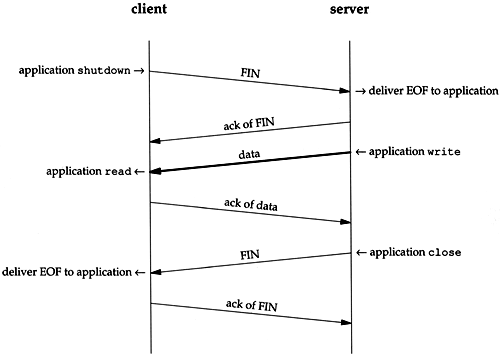18.5 TCP Half-Close
18.5 TCP Half-Close
TCP provides the ability for one end of a connection to terminate its output, while still receiving data from the other end. This is called a half-close. Few applications take advantage of this capability, as we mentioned earlier.
To use this feature the programming interface must provide a way for the application to say "I am done sending data, so send an end-of-file (FIN) to the other end, but I still want to receive data from the other end, until it sends me an end-of-file (FIN)."
The sockets API supports the half-close, if the application calls shutdown with a second argument of 1, instead of calling close. Most applications, however, terminate both directions of the connection by calling close.
Figure 18.10 shows a typical scenario for a half-close. We show the client on the left side initiating the half-close, but either end can do this. The first two segments are the same: a FIN by the initiator, followed by an ACK of the FIN by the recipient. But it then changes from Figure 18.4, because the side that receives the half-close can still send data. We show only one data segment, followed by an ACK, but any number of data segments can be sent. (We talk more about the exchange of data segments and acknowledgments in Chapter 19.) When the end that received the half-close is done sending data, it closes its end of the connection, causing a FIN to be sent, and this delivers an end-of-file to the application that initiated the half-close. When this second FIN is acknowledged , the connection is completely closed.
Figure 18.10. Example of TCP's half-close.

Why is there a half-close? One example is the Unix rsh (1) command, which executes a command on another system. The command
sun % rsh bsdi sort < datafile
executes the sort command on the host bsdi with standard input for the rsh command being read from the file named datafile. A TCP connection is created by rsh between itself and the program being executed on the other host. The operation of rsh is then simple: it copies standard input ( datafile ) to the connection, and copies from the connection to standard output (our terminal). Figure 18.11 shows the setup. (Remember that a TCP connection is full-duplex .)
Figure 18.11. The command: rsh bsdi sort < datafile.

On the remote host bsdi the rshd server executes the sort program so that its standard input and standard output are both the TCP connection. Chapter 14 of [Stevens 1990] details the Unix process structure involved, but what concerns us here is the use of the TCP connection and the required use of TCP's half-close.
The sort program cannot generate any output until all of its input has been read. All the initial data across the connection is from the rsh client to the sort server, sending the file to be sorted. When the end-of-file is reached on the input ( datafile ), the rsh client performs a half-close on the TCP connection. The sort server then receives an end-of-file on its standard input (the TCP connection), sorts the file, and writes the result to its standard output (the TCP connection). The rsh client continues reading its end of the TCP connection, copying the sorted file to its standard output.
Without a half-close, some other technique is needed to let the client tell the server that the client is finished sending data, but still let the client receive data from the server. Two connections could be used as an alternative, but a single connection with a half-close is better.
EAN: 2147483647
Pages: 378